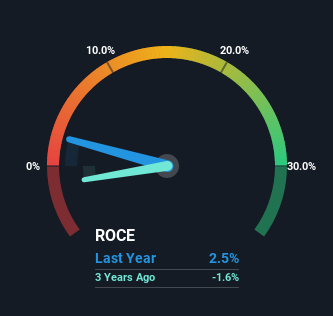- Saudi Arabia
- /
- Chemicals
- /
- SASE:2060
We Like These Underlying Return On Capital Trends At National Industrialization (TADAWUL:2060)
If we want to find a potential multi-bagger, often there are underlying trends that can provide clues. Typically, we'll want to notice a trend of growing return on capital employed (ROCE) and alongside that, an expanding base of capital employed. If you see this, it typically means it's a company with a great business model and plenty of profitable reinvestment opportunities. So when we looked at National Industrialization (TADAWUL:2060) and its trend of ROCE, we really liked what we saw.
Understanding Return On Capital Employed (ROCE)
For those that aren't sure what ROCE is, it measures the amount of pre-tax profits a company can generate from the capital employed in its business. Analysts use this formula to calculate it for National Industrialization:
Return on Capital Employed = Earnings Before Interest and Tax (EBIT) ÷ (Total Assets - Current Liabilities)
0.025 = ر.س514m ÷ (ر.س25b - ر.س5.2b) (Based on the trailing twelve months to September 2022).
So, National Industrialization has an ROCE of 2.5%. In absolute terms, that's a low return and it also under-performs the Chemicals industry average of 11%.
Check out our latest analysis for National Industrialization

In the above chart we have measured National Industrialization's prior ROCE against its prior performance, but the future is arguably more important. If you'd like, you can check out the forecasts from the analysts covering National Industrialization here for free.
What The Trend Of ROCE Can Tell Us
Even though ROCE is still low in absolute terms, it's good to see it's heading in the right direction. The data shows that returns on capital have increased by 241% over the trailing five years. The company is now earning ر.س0.03 per dollar of capital employed. Speaking of capital employed, the company is actually utilizing 27% less than it was five years ago, which can be indicative of a business that's improving its efficiency. If this trend continues, the business might be getting more efficient but it's shrinking in terms of total assets.
In Conclusion...
From what we've seen above, National Industrialization has managed to increase it's returns on capital all the while reducing it's capital base. And since the stock has fallen 24% over the last five years, there might be an opportunity here. With that in mind, we believe the promising trends warrant this stock for further investigation.
On a final note, we've found 1 warning sign for National Industrialization that we think you should be aware of.
For those who like to invest in solid companies, check out this free list of companies with solid balance sheets and high returns on equity.
Valuation is complex, but we're here to simplify it.
Discover if National Industrialization might be undervalued or overvalued with our detailed analysis, featuring fair value estimates, potential risks, dividends, insider trades, and its financial condition.
Access Free AnalysisHave feedback on this article? Concerned about the content? Get in touch with us directly. Alternatively, email editorial-team (at) simplywallst.com.
This article by Simply Wall St is general in nature. We provide commentary based on historical data and analyst forecasts only using an unbiased methodology and our articles are not intended to be financial advice. It does not constitute a recommendation to buy or sell any stock, and does not take account of your objectives, or your financial situation. We aim to bring you long-term focused analysis driven by fundamental data. Note that our analysis may not factor in the latest price-sensitive company announcements or qualitative material. Simply Wall St has no position in any stocks mentioned.
About SASE:2060
National Industrialization
Operates in the petrochemicals, chemicals, plastics, and metals sectors in the Kingdom of Saudi Arabia, rest of the Middle East, Asia, Africa, Europe, and internationally.
Good value with proven track record.
Similar Companies
Market Insights
Community Narratives





